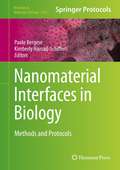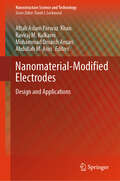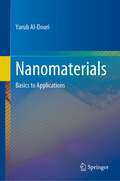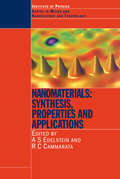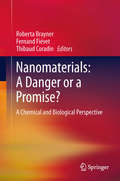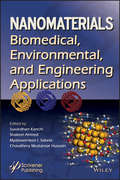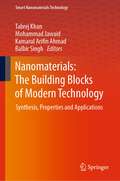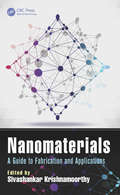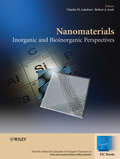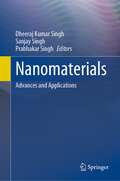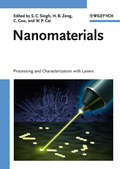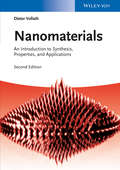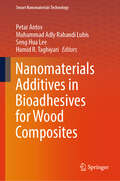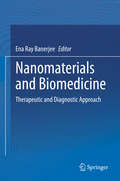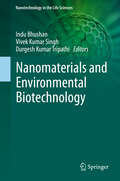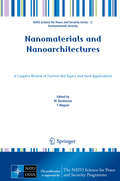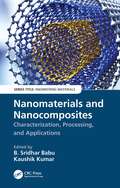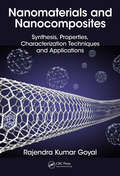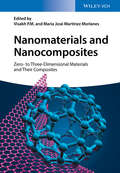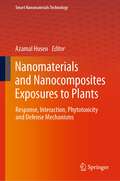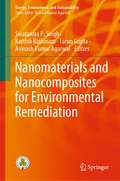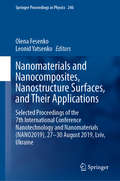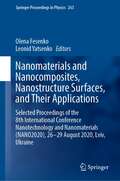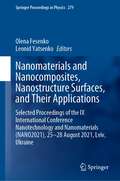- Table View
- List View
Nanomaterial Interfaces in Biology: Methods and Protocols
by Kimberly Hamad-Schifferli Paolo BergeseThe intersection of nanotechnology with biology has given rise to numerous ideas for new ways to use nanotechnology for biological applications. Nanomaterials possess unique size- and material-dependent properties which make them attractive for improving regular biomedical fields, such as drug delivery, imaging, therapy, and diagnostics. Divided into three convenient sections, Nanomaterial Interfaces in Biology: Methods and Protocols covers protocols describing synthesis, fabrication, and construction of bio-nanomaterial interfaces, characterization protocols of bio-nanomaterial interfaces, and applications which utilize the bio-nanomaterial interfaces. Written in the highly successful Methods in Molecular Biology series format, chapters contain introductions to their respective topics, lists of the necessary materials and reagents, step-by-step, readily reproducible laboratory protocols, and notes on troubleshooting and avoiding known pitfalls. Authoritative and accessible Nanomaterial Interfaces in Biology: Methods and Protocols will serve the new and emerging scientific community, enabling new capabilities and technologies that were not previously possible in medicine and biology.
Nanomaterial-Modified Electrodes: Design and Applications (Nanostructure Science and Technology)
by Aftab Aslam Parwaz Khan Raviraj M. Kulkarni Mohammad Omaish Ansari Abdullah M. AsiriThis contributed volume overviews the latest developments in the area of nanomaterial-modified electrodes and presents their unique biosensing, pharmaceutical and environmental applications. The book provides a comprehensive introduction on the basics of electrochemical sensors while also presenting overviews of multiple modified electrodes as essential elements for the development of sensors. The principle electrochemical sensors which are transducing the chemical/biochemical reactions to electrical signals are presented, while a special focus on lab-on-chips as well as the design and applications of various flexible electrodes is given. This book is of great benefit to researchers, graduate students and professionals working in the areas of biosensing, materials science, environmental engineering and pharmaceutical analysis.
Nanomaterials: Basics to Applications
by Yarub Al-DouriThis book includes the synthesis, analysis and characterization of nanomaterials that are an important ingredient in nanotechnologies. Nanomaterials contain nanoparticles, smaller than 100 nanometers in at least one dimension. Nanomaterials are coming into use in health care, electronics, cosmetics and other areas. Their physical and chemical properties differ from those of bulk materials. This needs to cover health risks to workers and potential risks to environment. This is currently done on a case-by-case basis, but risk assessment methods need to be kept up to date as the use of nanomaterials expands, especially as they find their way into consumer products. This book covers the basics to advanced applications of nanomaterials and provides a useful resource for researchers and professionals in the field.
Nanomaterials: Synthesis, Properties and Applications, Second Edition
by A S Edelstein R C CammarataNanomaterials: Synthesis, Properties and Applications provides a comprehensive introduction to nanomaterials, from how to make them to example properties, processing techniques, and applications. Contributions by leading international researchers and teachers in academic, government, and industrial institutions in nanomaterials provide an accessibl
Nanomaterials: A Danger or a Promise?
by Fernand Fiévet Thibaud Coradin Roberta BraynerWith the increased presence of nanomaterials in commercial products such as cosmetics and sunscreens, fillers in dental fillings, water filtration process, catalysis, photovoltaic cells, bio-detection, a growing public debate is emerging on toxicological and environmental effects of direct and indirect exposure to these materials. Nanomaterials: A Danger or a Promise? forms a balanced overview of the health and environmental issues of nanoscale materials. By considering both the benefits and risks associated with nanomaterials, Nanomaterials: A Danger or a Promise? compiles a complete and detailed image of the many aspects of the interface between nanomaterials and their real-life application. The full cycle of nanomaterials life will be presented and critically assessed to consider and answer questions such as: How are nanomaterials made? What they are used for? What is their environmental fate? Can we make them better? Including coverage of relevant aspects about the toxicity of manufactured nanomaterials, nanomaterials life cycle, exposure issues, Nanomaterials: A Danger or a Promise? provides a comprehensive overview of the actual knowledge in these fields but also presents perspectives for the future development of a safer nanoscience. This comprehensive resource is a key reference for students, researcher, manufacturers and industry professionals alike.
Nanomaterials: Biomedical, Environmental, and Engineering Applications (Advanced Material Series)
by Suvardhan Kanchi Shakeel Ahmed Myalowenkosi I. Sabela Chaudhery Mustansar HussainThis timely volume on nanomaterials and their biomedical and environmental applications includes the fundamentals of nanoparticles, and state-of-the-art properties, characterization, and the synthesis methods as well as the applications. The main thrust of the book is to present review chapters that explore all these aspects of nanomaterials for scientists, engineers and students who are fairly new to the field and want to have a deeper understanding of all the recent R & D advances. The 12 chapters are written by subject matter experts and plot the influence of nanomaterials on the analytical systems (macro to micro & lab-on-a-chip) for biomedical and environmental applications.
Nanomaterials: Synthesis, Properties and Applications (Smart Nanomaterials Technology)
by Tabrej Khan Mohammad Jawaid Kamarul Arifin Ahmad Balbir SinghThis book provides a general overview of different classes of nanomaterials, which includes the synthesis, fabrication, characterization, properties and technological applications of these materials. The book covers 4 main types of nanomaterials, namely: A) soft nanomaterials, B) biological nanomaterials, C) composite nanomaterials and D) green nanomaterials, where for each nanomaterials, a complete guide to material synthesis, characterization, their unique properties (as compared to a conventional bulk material) and potential technological applications is presented. One of the book's most notable characteristics is the inclusion of a section, a special focus on the future of nanomaterials for next-generation technology in electronic, power and energy devices. The content of this book is presented in a simple and lucid style which can also be used by professionals, scientists and students who are interested in the general research area of nanomaterials technology.
Nanomaterials: A Guide to Fabrication and Applications (Devices, Circuits, and Systems #Vol. 54)
by Sivashankar KrishnamoorthyNanomaterials are being incorporated into products all around us, having an incredible impact on durability, strength, functionality, and other material properties. There are a vast number of nanomaterials presently available, and new formulations and chemistries are being announced daily. <P><P> Nanomaterials: A Guide to Fabrication and Applications provides product developers, researchers, and materials scientists with a handy resource for understanding the range of options and materials currently available. Covering a variety of nanomaterials and their applications, this practical reference: <P><P> Discusses the scale of nanomaterials and nanomachines, focusing on integrated circuits (ICs) and microelectromechanical systems (MEMS) Offers insight into different nanomaterials’ interactions with chemical reactions, biological processes, and the environment Examines the mechanical properties of nanomaterials and potential treatments to enhance the nanomaterials’ performance Details recent accomplishments in the use of nanomaterials to create new forms of electronic devices Explores the optical properties of certain nanomaterials and the nanomaterials’ use in optimizing lasers and optical absorbers Describes an energy storage application as well as how nanomaterials from waste products may be used to improve capacitors Featuring contributions from experts around the globe, Nanomaterials: A Guide to Fabrication and Applications serves as a springboard for the discovery of new applications of nanomaterials.
Nanomaterials
by Robert A. Scott Charles M. LukehartConnecting inorganic chemistry to the hottest topic in materials science, this timely resource collects the contributions made by leading inorganic chemists towards nanomaterials research. The second volume in the "Wiley Encyclopedia of Inorganic Chemistry Methods and Applications Series," this signature title concentrates on recent developments in the field and includes all key topics such as nanowires, nanotubes, biomineralization, supramolecular materials and much more.This volume is also available as part of Encyclopedia of Inorganic Chemistry, 5 Volume Set.This set combines all volumes published as EIC Books from 2007 to 2010, representing areas of key developments in the field of inorganic chemistry published in the Encyclopedia of Inorganic Chemistry. Find out more.
Nanomaterials: Advances and Applications
by Dheeraj Kumar Singh Sanjay Singh Prabhakar SinghThis book highlights recent advances and evolution of various nanomaterials and their potential in diverse research fields. The book covers the synthesis and characterization of various nanomaterials, followed by discussion on desired applications such as clean and green renewable energy, coating, sensors, thermal applications, microelectronics, biomedical applications such as drug carriers, nutrition, biosensors and detection of cancer cells. The chapters in this book not only illustrate the capability of nanomaterials in such novel usages but also reveal their potential drawbacks and the possible ways to overcome the pitfalls. The book covers interdisciplinary research advancement of nanomaterials, beneficial for researchers and professionals working in both science and engineering.
Nanomaterials: Processing and Characterization with Lasers
by S. C. SinghThe first in-depth treatment of the synthesis, processing, and characterization of nanomaterials using lasers, ranging from fundamentals to the latest research results, this handy reference is divided into two main sections. After introducing the concepts of lasers, nanomaterials, nanoarchitectures and laser-material interactions in the first three chapters, the book goes on to discuss the synthesis of various nanomaterials in vacuum, gas and liquids. The second half discusses various nanomaterial characterization techniques involving lasers, from Raman and photoluminescence spectroscopies to light dynamic scattering, laser spectroscopy and such unusual techniques as laser photo acoustic, fluorescence correlation spectroscopy, ultrafast dynamics and laser-induced thermal pulses. The specialist authors adopt a practical approach throughout, with an emphasis on experiments, set-up, and results. Each chapter begins with an introduction and is uniform in covering the basic approaches, experimental setups, and dependencies of the particular method on different parameters, providing sufficient theory and modeling to understand the principles behind the techniques.
Nanomaterials
by Dieter VollathSuccessor of the highly acclaimed, first full-color introduction to nanomaterials - now including graphenes and carbon nanotubesThis full-colored introduction to nanomaterials and nanotechnology in particular addresses the needs of engineers who need to know the special phenomena and potentials, without getting bogged down in the scientific detail of the physics and chemistry involved.Based on the author's own courses, this textbook shows how to produce nanomaterials and use them in engineering applications for novel products. Following an introduction, the text goes on to treat synthesis, characterization techniques, thermal, optical, magnetic and electronic properties, processing and, finally, emerging applications.A sound overview of the "nano world" from an application-oriented perspective.Reviews for the first edition:"The reader [of this book] profits from the broad scientific teaching experience of the author.... This book is highly recommended for everyone who wants to step onto the new and fascinating field of nanomaterials." (International Journal of Materials Research, May 2009) "The practical presentation and clarity in writing style makes this book a winner for anyone wanting to quickly learn about the fundamentals and practical side of nanomaterials." (IEEE Electrical Insulation Magazine, March/April 2009)
Nanomaterials Additives in Bioadhesives for Wood Composites (Smart Nanomaterials Technology)
by Petar Antov Muhammad Adly Rahandi Lubis Seng Hua Lee Hamid R. TaghiyariThis book presents an overview of recent developments in the use of nanomaterials, such as nanocellulose, nanolignin, and nanoclay, in the synthesis of sustainable, bio-based adhesives for manufacturing high-performance, eco-friendly wood-based composites with enhanced properties, close-to-zero formaldehyde emission, and a lower environmental footprint for advanced value-added applications. In recent years, bio-based wood adhesives have received great attention as a sustainable alternative to the conventional synthetic adhesives used in the wood-based industry. However, bioadhesives based on natural and renewable feedstocks, such as protein, starch, lignin, and tannin, have inferior properties compared to thermosetting synthetic resins. Reinforcement with nanomaterials with a high aspect ratio has the potential to improve the performance of bio-based wood adhesives and the technological properties of wood composites. The book explores the present-day challenges and future prospects of using nanomaterials in bio-based wood adhesives. The content of this book appeals to materials scientists, wood scientists, environmental scientists, and wood-based panel industry professionals.
Nanomaterials and Biomedicine: Therapeutic and Diagnostic Approach
by Ena Ray BanerjeeThis book comprehensively reviews the history of nanotechnology, and describes the physiochemical properties of various nanoparticles and their biomedical applications. Covering the biotoxicity of nanoparticles, their bio-distribution and release kinetics, and their role in diagnosis, pre-clinical drug discovery and disease prevention, it also examines the application of nanoscaffolds in tissue engineering and as cell culture templates. Further, the book discusses several fabrication methodologies for regenerative medicine, and explores nanotechnology-based stem cell therapeutics, including stem cell transfection, stem cell delivery, and stem cell expansion for promoting tissue regeneration. Lastly, it addresses the use of DNA barcoding technology from nanosamples for the detection, identification and validation of emerging pathogens, biodiversity and ancient remnants of living specimens, and highlights various strategies for the plant-mediated synthesis of nanoparticles. Given its scope, it is a valuable reference resource for graduate students and researchers interested in understanding the diverse range of biomedical applications of nanoparticles.
Nanomaterials and Environmental Biotechnology (Nanotechnology in the Life Sciences)
by Vivek Kumar Singh Durgesh Kumar Tripathi Indu BhushanNanotechnology is considered as one of the emerging fields of science. It has applications in different biological and technological fields which deal with the science of materials at nanoscale (10-9). On the other hand, biotechnology is another field that deals with contemporary challenges. Nanobiotechnology fills the gap between these two fields. It merges physical, chemical, and biological principles in a single realm. This combination opens up new possibilities. At nanoscale dimensions, it creates precise nanocrystals and nanoshells. Integrated nanomaterials are used with modified surface layers for compatibility with living systems, improved dissolution in water, or biorecognition leading to enhanced end results in biotechnological systems. These nanoparticles can also be hybridized with additional biocompatible substances in order to amend their qualities to inculcate novel utilities. Nanobiotechnology is used in bioconjugate chemistry by coalescing up the functionality of non-organically obtained molecular components and biological molecules in order to veil the immunogenic moieties for targeted drug delivery, bioimaging and biosensing. This book blends the science of biology, medicine, bioinorganic chemistry, bioorganic chemistry, material and physical sciences, biomedical engineering, electrical, mechanical, and chemical science to present a comprehensive range of advancements. The development of nano-based materials has made for a greater understanding of their characterization, using techniques such as transmission electron microscope, FTIR, X-ray diffraction, scanning electron microscope EDX, and so on. This volume also highlights uses in environmental remediation, environmental biosensors and environmental protection. It also emphasizes the significance of nanobiotechnology to a series of medical applications viz., diagnostics, and therapeutics stem cell technology, tissue engineering enzyme engineering, drug development and delivery. In addition this book also offers a distinctive understanding of nanobiotechnology from researchers and educators and gives a comprehensive facility for future developments and current applications of nanobiotechnology.
Nanomaterials and Nanoarchitectures
by M. Bardosova T. WagnerThe current work consists of nine contributions describing recent progress in the interdisciplinary of Nanoscience, which involves physics, chemistry, engineering, biology and medicine and one essay outlining some important historical and socioeconomic factors pertaining to recent developments in nanoscale science and technology. All 10 chapters have been written by eminent experts in their respective fields. The authors employ the terms 'nanomaterials' as building blocks of a range of materials, 'nanoarchitecture' represents the design and 'nanotechnology' the means to produce a particular device or functionality. Two of the chapters are devoted to novel materials and two others focus on analyzing techniques, which can be used to enable molecular control of the film architecture. Additionally, the reader will find material devoted to photonic and hybrid plasmonic-photonic crystals as well as sections which address their applications, such as the use of plasmonic particles and nanostructures for new sensing concepts and ultrasensitive detection techniques. This work will be of interest to graduate students, researchers and practitioners alike.
Nanomaterials and Nanocomposites: Characterization, Processing, and Applications (Engineering Materials)
by B. Sridhar Babu Kaushik KumarNanomaterials and Nanocomposites: Characterization, Processing, and Applications discusses the most recent research in nanomaterials and nanocomposites for a range of applications as well as modern characterization tools and techniques. It deals with nanocomposites that are dispersed with nanosized particulates and carbon nanotubes in their matrices (polymer, metal, and ceramic). In addition, the work: Describes different nanomaterials, such as metal and metal oxides, clay and POSS, carbon nanotubes, cellulose, and biobased polymers in a structured manner Examines the processing of carbon nanotube-based nanocomposites, layered double hydroxides, and cellulose nanoparticles as functional fillers and reinforcement materials Covers size effect on thermal, mechanical, optical, magnetic, and electrical properties Details machining and joining aspects of nanocomposites Discusses the development of smart nanotextiles (intelligent textiles), self-cleaning glass, sensors, actuators, ferrofluids, and wear-resistant nanocoatings. This book enables an efficient comparison of properties and capabilities of these advanced materials, making it relevant for materials scientists and chemical engineers conducting academic research and industrial R&D into nanomaterial processing and applications.
Nanomaterials and Nanocomposites: Synthesis, Properties, Characterization Techniques, and Applications
by Rajendra Kumar GoyalThe main aims of this book are to summarize the fundamentals, synthesis methods, properties and applications of nanomaterials, so as to provide readers with a systematic knowledge on nanomaterials. In addition, the book covers most commonly used characterization tools pertaining to nanomaterials. Further, it deals with relevant aspects of nanocomposites which contains dispersion of nano-sized particulates, and carbon nanotubes (CNTs) in the matrices (polymer, metal and ceramic). It also discusses development of smart nano textiles (intelligent textiles), self-cleaning glass, sensors, actuators, ferro-fluids, and wear resistant nano coatings. Aimed at senior undergraduate and graduate students, the key features on this book include: Top-down and bottom-up approaches for the synthesis of nanomaterials included Illustrates sample preparation and basic principle of characterization tools for nanomaterials Explains calculation of ratios of surface area to volume and surface atoms to bulk atoms Reviews synthesis, properties and applications of carbon nanotubes and magnetic nanomaterials Discusses size effect on thermal, mechanical, optical, magnetic and electrical properties
Nanomaterials and Nanocomposites: Zero- to Three-Dimensional Materials and Their Composites
by Visakh P. M. María José MorlanesNanomaterials are defined as materials in which at least one length dimension is below 100 nanometers. In this size regime, these materials exhibit particular - and tunable - optical, electrical or mechanical properties that are not present at the macro-scale. This opens up the possibility for a plethora of applications at the interface of materials, chemistry, physics and biology, many of which have already entered the commercial realm. When nanomaterials are blended with other materials not necessarily in the nanometer regime, the resulting nanocomposites can exhibit dramatically different properties than the bulk material alone, leading to an enhanced performance in terms of, for example, increased thermal and mechanical stability. This book presents the synthesis, characterization and applications of nanomaterials and nanocomposites, covering zero-dimensional, elemental nanoparticles, one-dimensional materials such as nanorods and nanowhiskers, two-dimensional materials such as graphene and boron nitride as well as three-dimensional materials such as fullerenes, polyhedral oligomers and zeolites, complemented by bio-based nanomaterials, e.g., cellulose, chitin, starch and proteins. Introductory chapters on the state-of-the-art of nanomaterial research and the chemistry and physics in nanoscience and nanotechnology round off the book.
Nanomaterials and Nanocomposites Exposures to Plants: Response, Interaction, Phytotoxicity and Defense Mechanisms (Smart Nanomaterials Technology)
by Azamal HusenThis book looks at the interaction between plants and nanomaterials/nanocomposites, and their effects ecology, the food chain and human health. It focuses on nanomaterials/nanocomposites phytotoxicity, which is an important precondition to promote the application of nanotechnology and to avoid the potential ecological risks. It describes the influencing factors of nanotoxicity of nanomaterials and the mechanisms of these toxic effects and defense mechanisms in plants. The chapters in this book are written by internationally renowned researchers and professionals and provides exciting and remarkable information (on the above-mentioned topics) to the scientist, researcher and student working field of plant biology, agricultural science, nanobiotechnology, plant biochemistry, plant physiology, plant biotechnology and many other interdisciplinary subjects.
Nanomaterials and Nanocomposites for Environmental Remediation (Energy, Environment, and Sustainability)
by Swatantra P. Singh Karthik Rathinam Tarun Gupta Avinash Kumar AgarwalThis monograph focuses on recent development of nanomaterials and nanocomposites for pollution measurement and their control in water, air, and soil. The contents incorporate carbon-based, metal-based, and metal-organic framework based nanomaterials and nanocomposites for emerging contaminants (pharmaceuticals and personal care products) degradation, disinfection, and other traditional pollutants degradation and removal. The book also offers updated literature for researchers and academicians working in the field of environmental remediation by nanomaterials. Readers will learn about different metal and non-metal based nanoparticles for environmental remediation. It will be a useful guide for professionals, and post-graduate students involved in material science & engineering, chemical engineering and environmental nanotechnology research.^
Nanomaterials and Nanocomposites, Nanostructure Surfaces, and Their Applications: Selected Proceedings of the 7th International Conference Nanotechnology and Nanomaterials (NANO2019), 27 – 30 August 2019, Lviv, Ukraine (Springer Proceedings in Physics #246)
by Olena Fesenko Leonid YatsenkoThis book highlights some of the latest advances in nanotechnology and nanomaterials from leading researchers in Ukraine, Europe and beyond. It features contributions presented at the 7th International Science and Practice Conference Nanotechnology and Nanomaterials (NANO2019), which was held on August 27–30, 2019 at Lviv Polytechnic National University, and was jointly organized by the Institute of Physics of the National Academy of Sciences of Ukraine, University of Tartu (Estonia), University of Turin (Italy), and Pierre and Marie Curie University (France). Internationally recognized experts from a wide range of universities and research institutions share their knowledge and key findings on material properties, behavior, and synthesis. This book’s companion volume also addresses topics such as nano-optics, energy storage, and biomedical applications.
Nanomaterials and Nanocomposites, Nanostructure Surfaces, and Their Applications: Selected Proceedings of the 8th International Conference Nanotechnology and Nanomaterials (NANO2020), 26–29 August 2020, Lviv, Ukraine (Springer Proceedings in Physics #263)
by Olena Fesenko Leonid YatsenkoThis book highlights some of the latest advances in nanotechnology and nanomaterials from leading researchers in Ukraine, Europe and beyond. It features contributions presented at the 8th International Science and Practice Conference Nanotechnology and Nanomaterials (NANO2020), which was held on August 26–29, 2020 at Lviv Polytechnic National University, and was jointly organized by the Institute of Physics of the National Academy of Sciences of Ukraine, University of Tartu (Estonia), University of Turin (Italy), and Pierre and Marie Curie University (France). Internationally recognized experts from a wide range of universities and research institutions share their knowledge and key findings on material properties, behavior, and synthesis. This book’s companion volume also addresses topics such as nano-optics, energy storage, and biomedical applications.
Nanomaterials and Nanocomposites, Nanostructure Surfaces, and Their Applications: Selected Proceedings of the IX International Conference Nanotechnology and Nanomaterials (NANO2021), 25–28 August 2021, Lviv, Ukraine (Springer Proceedings in Physics #279)
by Olena Fesenko Leonid YatsenkoThis book highlights some of the latest advances in nanotechnology and nanomaterials from leading researchers in Ukraine, Europe and beyond. It features contributions presented at the 8th International Science and Practice Conference Nanotechnology and Nanomaterials (NANO2020), which was held on August 25–28, 2021 at Lviv Polytechnic National University, and was jointly organized by the Institute of Physics, the National Academy of Sciences of Ukraine, Lviv Polytechnic National University, University of Tartu (Estonia), University of Turin (Italy), Pierre and Marie Curie University (France), European Profiles S.A. (Greece), Representation of the Polish Academy of Sciences in Kyiv, University of Angers (France), Ruprecht Karl University of Heidelberg (Germany). Internationally recognized experts from a wide range of universities and research institutions share their knowledge and key findings on material properties, behavior, and synthesis. This book’s companion volume also addresses topics such as nano-optics, energy storage, and biomedical applications.
Nanomaterials and Nanocomposites, Nanostructures, and Their Applications: Selected Proceedings of the 11th International Conference on Nanotechnology and Nanomaterials (NANO-2023), August 16-19, 2023, Bukovel, Ukraine (Springer Proceedings in Physics #253)
by Olena Fesenko Leonid YatsenkoThis book highlights some of the latest advances in nanotechnology and nanomaterials from leading researchers in Ukraine, Europe and beyond. It features contributions presented at the 11th International Conference on Nanotechnologies and Nanomaterials, and was jointly organized by the Institute of Physics of the National Academy of Sciences of Ukraine, University of Tartu (Estonia), University of Turin (Italy), and Pierre and Marie Curie University (France). Internationally recognized experts from a wide range of universities and research institutions share their knowledge and key findings on material properties, behavior, synthesis and their applications. The book will be interesting for leading scientists, advanced undergraduate and graduate students in material and nanoscience. This book’s companion volume also addresses topics such as nano-optics, nanoelectronics, energy storage and nanochemistry applications.
